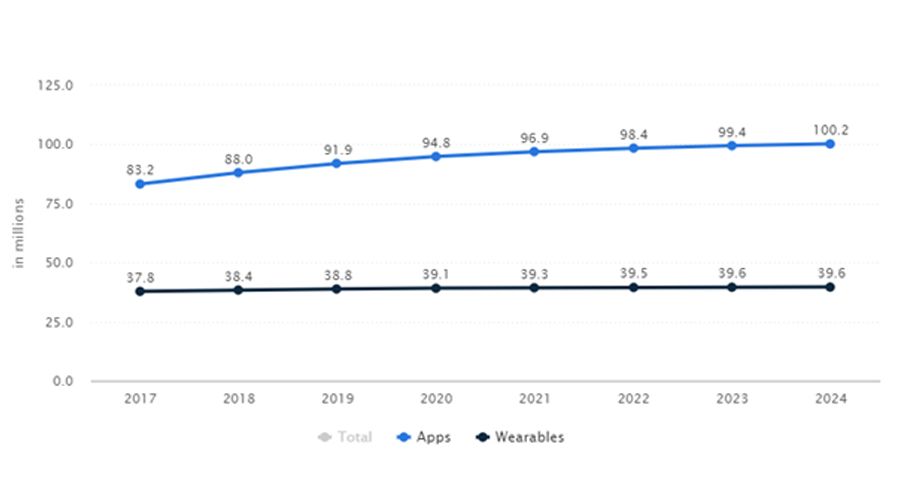Fitness App Industry - The most demanding template to grow your wellness business
Fitness exercises are boon to both physical and mental wellness. As per the American Heart Association, one can improve physical strength while keeping good fitness with regular exercises. Despite having an urge, most fitness freaks lose their nerves when it comes to costly gym subscriptions each month.
But, we can well say the digitalization of technology is way ahead to ramp up our desire of expectations at much-reduced expenses. Fitness mobile applications certainly serve as a platform for fitness geeks to go with regular exercise regimes at ease, and undoubtedly, these apps have made staying fit much easier and time-saving for all too.
Today, there are more than 2 million fitness apps made available across iOS alone, while Android enjoys a slight edge over its counterpart and is leading with 2.2 million apps available in its Playstore as of 2019. Although standing just below music apps, fitness apps are growing largely focusing on convenience for the users both in terms of cost-savings and health benefits while helping businesses facilitate revenue generation. Given an unprecedented user interest for fitness apps, the fitness app industry adds more value to the global market growth which is worth $94 billion currently.
Here we present an insightful study to analyze how fitness apps today help businesses grow and enable users to have a well-planned action to improve their performance. In addition, the role of app mobile development companies is pivotal too as they curve ideas into the best innovation reflecting the goal of a business as well as the user expectation.
Value the Fitness App Industry Is Generating For Businesses
The fitness app is not confined only to well-equipped and curated fitness videos and steps. When it comes to the fitness app industry, it covers a diverse range including wearable technology embedded into the fitness apps. Apart from it, the fitness mobile applications are explicitly intended for nutrition apps too that carefully perform calorie checks, nutrition needs checks, and the achievements of fitness goals through fitness and activity tracking. In the app segments, users can find apps that meet their needs diversely like that of diabetes apps and others.
As a whole, the fitness app industry is centralized around three basic app segments such as workout and exercise apps, activity tracking apps, and nutrition apps. Let’s not forget the target deployment of these apps is Android, iOS, and Windows platforms. And the target audiences are fitness product manufacturers, sports product manufacturers, and smartphone app developers.
As per reports from the Marketwatch, the fitness app industry is expected to grow at a CAGR of 12% taking its total revenue to $15,546.97 million by 2023. App manufacturers and app development companies therefore have more reasons to count for scalability and recognition.
Also Read : [MEAN Stack Development Explained: Why Business Must Look For This Framework?]
Fitness App revenues
Based on downloads and user engagement to fitness apps and also wearable technologies, the app revenue is estimated to grow US$727.0 m by 2024 whereas wearable technologies are to touch the growth mark of US$3,843.8m during the same period.
Figure 1 Source: Global Market Insights
In addition, app revenue per users also sees a surge. It amounts to US$6.73 in 2020.
Figure 2 App revenue per user (Source: Statistica.com)
Increase of User Penetration
You can expect around 100.2 m of fitness app users by 2024. Simultaneously, young populations contribute to a large share as much as 34.4%.
Figure 3 App users (Statistica.com)
Figure 4 Age-wise users (Statistica.com)
The Download of Fitness Apps amid Covid-19
Owing to the sudden outbreak of the Covid-19 pandemic, gyms and fitness studios have stopped operating from its physical locations and without its on-site staff. Besides that, social isolation has contributed to mental stress and anxiety which is far too vulnerable for people
to stay healthy. One of the best ways to have strong immunity is to perform some useful exercises and eat a balanced diet. Amid the situation, while it is not possible to attend gyms and boutique fitness studios, reinventing ways to connect with the users is the perfect solution to stay abreast even during the crisis. Virtual video classes have grown in numbers. Simultaneously, fitness app downloads between March 22 and 28 have seen a surge by 45% globally and 10% of consumer spends on the apps. The growth of at-home fitness apps has been dramatic too, adding an increase of up to 40%. Some of the premium workouts in the app are planning to be made available at zero costs for users up to two-three months from now.
Figure 5 Fitness App Downloads Amid Lockdown
This analysis here aptly suggests how fitness app manufacturers can make big in the coming years well with a great deal of support from an established app development company.











